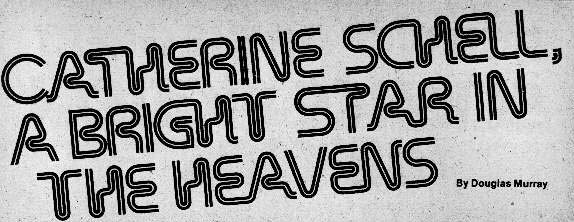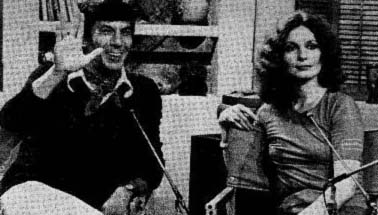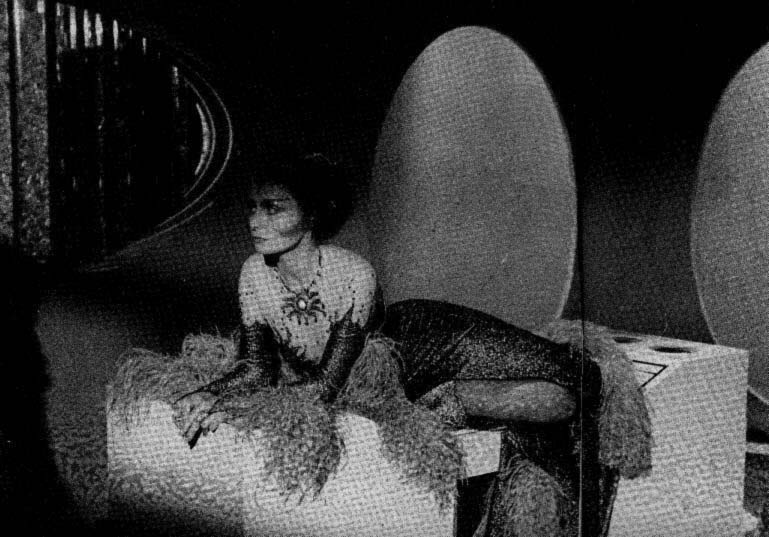
fully expressive features
made her a perfect choice
for the role of Maya. Her abil-
ity to change herself into dif-
ferent life forms became the
crux of most of the second-
season episodes of SPACE:
1999.
Catherine Schell, as Maya, Strikes a seductive pose.


of the space world, Catherine Schell and
Leonard Nimoy, discuss their extraterres-
trial roles on a local television program.
There are very few actresses who
have made their mark in the modern
movie field. Certainly, people like
Elizabeth Taylor and Bette Davis were
(and are) big stars -- but they existed
in the era of the big studios, and the
big publicity push. Since that time, only
a few have made it to star status -- and
these few have been blessed with visible
roles in multi-million dollar pictures.
Occasionally, someone will make it
in "B" pictures, move up to featured
roles in A-films, and eventually become
a star on television. One of these
beauties is Angie Dickenson. Another
is Catherine Schell.
Catherine Schell started her career
in the west with an appearance in a
science fiction film produced by a
horror film company.
Britain's Hammer films had become
world-renowned for their forays into the
horror market. Their Dracula and
Frankenstein films had become im-
mensely popular around the world and
their developed starts, Peter Cushing and
Christopher Lee, had become inter-
nationally famous.
But the company had never develop-
ed a real female star. Instead they
alternated beautiful girls from film to
film, never insuring one career with
a succession of roles.
Likewise, they had never developed
an alternate film repertoire (aside from
their horror films) to draw from. But
this was becoming something of a prob-
lem.
Finally, in 1967, Hammer decided
to remedy both situations -- they would
return to the science-fiction film, the
genre that helped launch the company
the Four Sided Triangle. They would
develop a new series of such movies,
starring a new romantic duo -- one still
relatively unknown (hence cheap), yet
one whom they felt had untold promise.
Moon Zero Two had been born.
Moon Zero Two was the designa-
tion (name if you will) of a kind of
space tugboat owned by astronaut
James Olsen. He had been removed
from the Earth-to-Moon rocket run
because of troubles with the company
(he had a tendency toward individualism),
and had set up his own free-lance
charter service-cum-mining operation.
His little world is shattered by two
events -- the coming of Catherine
Schell looking for her prospector
brother, whom Olsen had ferried to
his claim, and the arrival of Donald
Pleasance, who wants to hire Moon
Zero Two for a somewhat shady enter-
prise. Eventually both events merge into
one -- it was Pleasance who ordered
Schell's brother killed because of his
"claim," and Pleasance who threatens
Olsen and Schell unless Olsen will
cooperate in setting down a solid
diamond asteroid on his newly acquired
property. Needless to say, the dashing
duo finally manage to defeat the
dastardly villian, and are last seen
coming to terms with their new partner-
ship in their roaring rocket.
If all this sounds familiar, its be-
cause the whole film was conceived as
a "Space Western." The script is
interchangeable with just about any
of Roy Rogers' programs from the '50's,
with the dastardly rich banker killing
the harmless prospector who's finally
struck it rich, while the prospector's
lovely sister begs the stalwart sheriff
for aid. Very familiar stuff. So familiar,
the public stayed away in droves.
But Schell and Olsen were not
